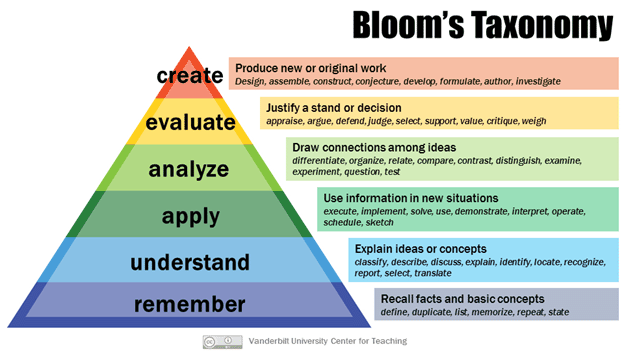What are Course Learning Objectives?
Course Learning Objectives, or CLOs are specific statements of what students will be able to do when they successfully complete a course. 5-10 objectives are recommended per course.
Course Learning Objectives…
- Focus on the primary insights gained from the coursework
- Should be observable and measurable so that you are able to evaluate whether learners have achieved the objectives expected. In other words, learning objectives use action verbs to describe what it looks like when learners achieve the learning objectives.
- Identify the specific knowledge and skills that one should be able to do at the end of the course. Articulating objectives – and communicating them clearly and understandably to learners – has benefits to both learners and educators.
Why are Course Learning Objectives Important?
Learning objectives serve as the compass guiding students towards success in the course. By clearly outlining expectations, learning objectives provide transparency and ensure that students comprehend the journey ahead, fostering a meaningful and enriching educational experience.
How to Write Effective Course Learning Objectives
1. Utilize S.M.A.R.T. Attributes: Learning objectives should embody the following S.M.A.R.T. attributes.
Specific: Clear and succinct statements outlining what students will achieve.
Measurable: Goals that indicate how students will be evaluated. Begin with action verbs observable through tests, assignments, or projects (e.g., define, apply, propose).
Attainable: Goals that align with students' existing knowledge and skills, and with a course duration allowing for goal achievement.
Relevant: Skills or knowledge outlined are pertinent to the course or program context.
Time-bound: Clearly state when students should demonstrate the skill (end of the course, semester, etc.).
2. Choose Action Verbs
Another helpful tip for writing learning objectives is to pick action verbs that show what students should do and can be easily seen and measured. Bloom’s taxonomy offers a bunch of these verbs, grouped by how well students should do something. Using clear verbs makes your objectives easier to understand. Here's a list of some good verbs to use when writing learning objectives:
assemble, construct, create, develop, compare, contrast, appraise, defend, judge, support, distinguish, examine, demonstrate, illustrate, interpret, solve, describe, explain, identify, summarize, cite, define, list, name, recall, state, order, perform, measure, verify, relate.
Try to stay away from these verbs - they’re too vague and hard to measure:
appreciate, cover, realize, be aware of, familiarize, study, become acquainted with, gain knowledge of, comprehend, know, learn, understand.
3. Bloom’s Taxonomy can be a useful guide to building CLOs
- Remembering: Learners should be able to recall …
- Understanding: Learners should be able to explain the importance and impact of the …
- Applying: Learners should be able to apply …
- Analyzing: Students should be able to analyze data …
- Evaluating: Learners should be able to recommend …
- Creating: Learners should be able to integrate knowledge …
4. When composing learning outcomes, you might see some common stems, like:
- At the end of the course, learners should be able to…
- Upon completion of this course, learners will be able to…
- Learners should be able to…
For more information on creating Course Learning Objectives, email SupportDesk@iit.edu, attn: CLI and ask to make an appointment with our instructional designer. We’ll be happy to talk more with you about this important process.


